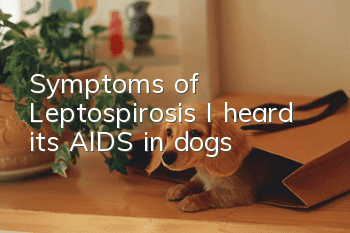Symptoms of Leptospirosis: I heard it’s AIDS in dogs

What is leptospirosis
It is a zoonotic disease. Dogs are also susceptible to this disease. There are dozens of types of Leptospira. my country has isolated 8 types from dogs. The canine type is the most common, followed by the jaundice-hemorrhagic type and the Pomona type.
Leptospirosis transmission routes
Almost all warm-blooded animals can be infected, and can exist in infected animals for a long time and become the main reservoir host . For example, after rodents are infected, most of them are healthy carriers. They carry the bacteria for a long time and can excrete the bacteria through urine, becoming an important source of infection. Sick animals can excrete bacteria in their urine, contaminating water sources and soil. When dogs come into contact with these bacteria-contaminated water, soil or urine, they can become infected through damaged skin, mucous membranes and digestive tracts. And the possibility of infection through sexual intercourse is very high, because male dogs have the habit of sniffing and licking their own or female dogs' genitals with their nose and tongue.
Symptoms of leptospirosis
Some symptoms are obvious, such as high fever, mucosal bleeding, jaundice, ulcers or necrosis, and hemoglobinuria in sick dogs; It is a latent process and lacks obvious clinical symptoms.
Sick dogs caused by jaundice-type Leptospira hemorrhage start with high fever, and then drop to normal temperature or below the next day. Jaundice then develops in the conjunctiva and oral mucosa. Sick dogs suffer from physical weakness, loss of appetite, vomiting, depression, and weakness in limbs (especially hind limbs). The urine output is reduced and is yellow-red, sometimes mixed with blood in the stool. Secondly, the symptoms of jaundice caused by Leptospira canis are not obvious. It usually manifests as vomiting, bloody stools, abdominal pain, bad breath, mucosal ulcers, tongue necrosis and ulcers. The lumbar vertebrae are sensitive to pressure, causing polyuria. The urine contains a large amount of protein and bilirubin. Most sick dogs die of uremia.
LeptospirosisEpidemic characteristics
The occurrence of the disease is often closely related to contact with the urine of sick dogs or infected rats. Generally, male dogs are more susceptible to the disease, and young dogs are more susceptible to the disease than older dogs, often sporadic.
LeptospirosisNeopsy characteristics
Usually characterized by jaundice, bleeding in various organs, and necrosis of the gastrointestinal mucosa. Ascites increases, often mixed with blood, there are small bleeding spots in the intestinal mucosa, hepatomegaly, and the gallbladder is filled with bile with blood. Based on the above characteristics, a preliminary diagnosis can be made. Confirmation depends on pathogenic testing and serological testing.
Leptospirosis prevention and control measures
1. Prevent dogs from coming into contact with infected animals (especially pigs and rodents) and water and feed contaminated by their urine. Polluted environments can be disinfected with 2% to 5% bleach solution, 2% sodium hydroxide, or 3% Lysol.
2. Repel rats and eliminate rats.
3. It is strictly prohibited to feed sick meat and raw meat and products of infected animals.
4. Larger dog groups should be quarantined once a year. If sick dogs and suspected infected dogs are found, they should be isolated in time. Penicillin and streptomycin can be used early and have better effects. However, treatment must be continued for 3 to 5 days to eliminate Juntospira in the kidneys.
5. Inject vaccines. At present, there is no monovalent Juntospira vaccine for dogs in my country, but there is a six-combination vaccine combined with other vaccines in China, which can be used to vaccinate dogs, but the vaccine must include the main local prevalent bacterial types. If the vaccine is sterile, drug prevention can be used during the epidemic period, that is, adding oxytetracycline (0.75 to 0.5 grams of oxytetracycline per kilogram of feed) or tetracycline (1 to 1.5 mg/kg of body weight) in the feed. , feeding for 7 days can control the infection in dogs.
- What do dogs eat to protect their stomach? It is important to protect their stomach and treat gastrointestinal diseases in dogs.
- How to tell if your dog is fat? Is your dog overweight?
- Will your dog catch a cold if you blow the air conditioner? What should you do if your dog catches a cold if you blow the air conditioner?
- What should you pay attention to when your dog drinks water? Don’t be careless when it comes to your dog’s drinking water.
- The dog's mouth bites and shakes. Why does the dog's mouth occasionally shake and bite?
- How to cut a dog's hair? Do you know how to cut a dog's hair correctly?
- Can dogs eat raw eggs? Why can’t dogs eat egg whites?
- Common Dog Problems in Summer How to Deal with Different Dog Problems
- How to keep dogs away from skin diseases. If you do this, will you see if your dog will still be infected with skin diseases?
- What causes anorexia in dogs? Dogs will become anorexic due to lack of exercise. Hounds run at least 5KM every day.



